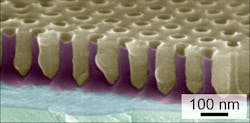Upton, NY--In a paper entitled "Enhanced charge collection in confined bulk heterojunction organic solar cells" published online October 17, 2011 in Applied Physics Letters, theU.S. Department of Energy’s (DOE) Brookhaven National Laboratory explains how to improve the electricity output of a semiconductor material used in polymer-based solar cells. By confining the light-absorbing/charge-separating material within nanometer-scale pores, instead of using it in continuous thin-film sheets, the scientists enhanced the material’s electrical conductivity by more than 500X, and produced polymer solar cells with twice the electricity output for the same amount of absorbed sunlight. The research suggests that nanoscale restructuring could make polymer-based solar cells--potentially manufactured as inexpensively as plastics--more competitive in the marketplace.
"Judged by their physical properties, organic semiconductors should be more efficient at converting sunlight to electricity than they are," said Charles Black, group leader for electronic materials at Brookhaven’s Center for Functional Nanomaterials (CFN). "One of the goals of our research is to understand why--and to devise new solar cell architectures to improve them."
The team believes the orientation of crystal stacking in a thin film arrangement actively blocks the out-of-plane movement of electrical current. However, confining the same material within nanopores inhibits such long-range crystal alignment, thus removing the roadblocks to out-of-plane current flow.
Solar cells made from the reconfigured material produce twice as much electricity for the same amount of absorbed sunlight, compared to an unconfined, continuous film. While this is a substantial improvement in the material performance, the overall solar device efficiency remains unimproved because the confining nanostructured template occupies valuable space. And that space is not generating electricity.
The team is exploring ways to minimize that wasted space to better leverage the improved material performance. They also plan to investigate whether the nano-containment approach could provide similar benefits for other organic solar materials.
SOURCE: Brookhaven National Laboratory; www.bnl.gov/today/story.asp?ITEM_NO=2563
IMAGE: An angled view shows an aluminum oxide template (gray) with a regular array of 60 nm holes filled with an organic semiconductor (purple). This nanoconfined semiconducting polymer produces twice the amount of electricity for a given amount of absorbed sunlight as compared to the same material spread as a thin film.(Courtesy Brookhaven National Laboratory)
